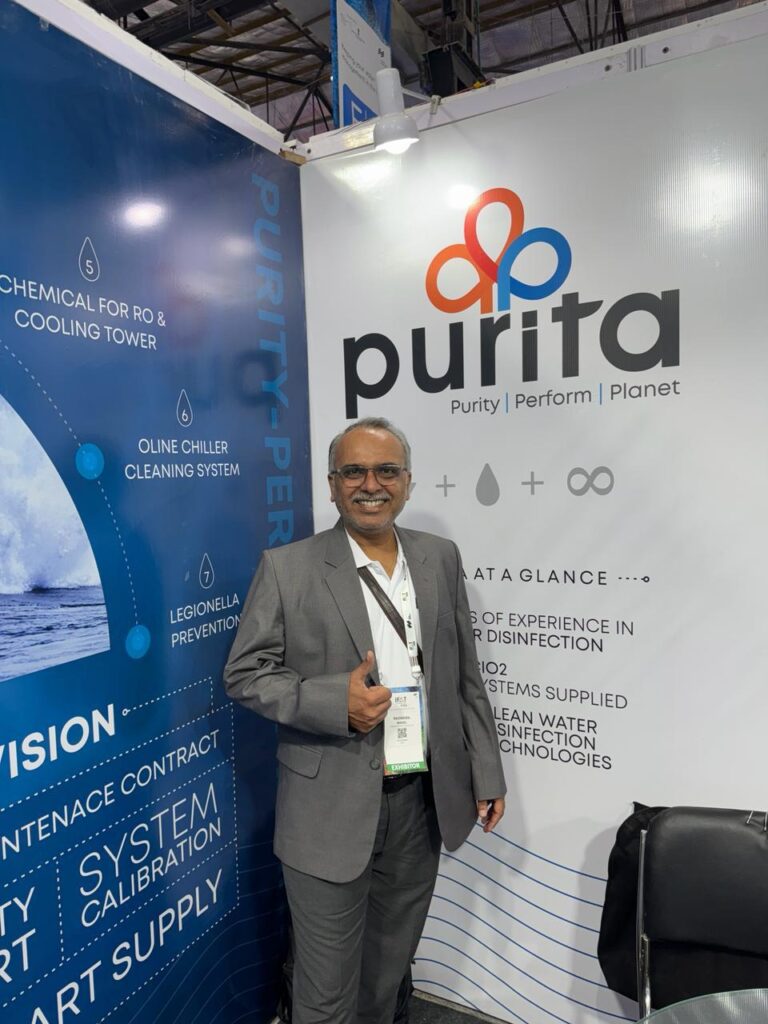M/s Purita Water Solutions Pvt Ltd had the privilege of participating in the prestigious IFAT 2024 exhibition held at NESCO. The event provided a fantastic platform for showcasing innovative water solutions, and we are grateful to IFAT for being such a wonderful host to this remarkable exhibition.
A big thank you to all the visitors who took time out of their busy schedules to visit our booth. It was a pleasure to connect with industry professionals, share insights, and discuss how our solutions can help meet the evolving water management needs.
We look forward to building on the connections made and are excited to collaborate further with our potential partners. M/s Purita Water Solutions Pvt Ltd remains committed to providing the best solutions to meet the expectations of our valued clients. Here’s to continued growth and collaboration in the future!




NTPC Vindhyachal recently celebrated the 54th National Safety Week with a focus on reinforcing the importance of safety in the workplace. The event was organized by M/s Purita Water Solutions Pvt Ltd and aimed to raise awareness about safety protocols, promote best practices, and ensure a safer working environment for all employees.
The event saw Shreeram Yadav, Senior Manager at MM/Offsite, NTPC Vindhyachal, grace the occasion as the guest of honor. His presence highlighted the significance of safety measures in large-scale industrial settings like NTPC Vindhyachal, where rigorous safety standards are essential to ensure the well-being of all personnel.
The 54th National Safety Week celebrations provided an opportunity for everyone to reflect on safety practices, discuss improvements, and commit to maintaining the highest safety standards. Such initiatives are crucial for fostering a safety-first culture, which is integral to NTPC Vindhyachal’s operations.


Industries That Benefit from Chlorine Dioxide Systems
Chlorine dioxide (ClO₂) is a versatile disinfectant and oxidizing agent used across many industries for its effectiveness in controlling microbial contamination, biofilm formation, and odor. Here’s a list of industries that benefit from chlorine dioxide systems:
- Drinking Water Treatment
- Industrial Water Treatment
- Control Legionella and other harmful bacteria in cooling towers.
- Prevent the formation of biofilms and scaling in heat exchangers and pipes.
- Improve water quality in industrial processes, including pulp and paper manufacturing, petrochemical plants, and textile industries.
- Food and Beverage Processing
- Surface Sanitization: Chlorine dioxide disinfects equipment, conveyors, and surfaces in food processing plants, ensuring safe handling of food products.
- Water Treatment: Chlorine dioxide is used in water systems to prevent microbial contamination in water used for cleaning, cooling, and processing.
- Fruit and Vegetable Washing: Chlorine dioxide is often used to wash produce, as it is effective in reducing microbial load without leaving harmful residues.
- Healthcare and Medical Facilities
- Surface Disinfection:For cleaning and sanitizing patient rooms, operating theaters, and medical equipment.
- Air Sterilization: Chlorine dioxide can be used to purify air and reduce the spread of airborne pathogens in healthcare settings.
- Water Systems: Preventing microbial growth in hospital water systems, including those supplying dialysis units, sinks, and HVAC systems.
- Municipal Wastewater Treatment
- Odor Control: Chlorine dioxide neutralizes sulfur compounds, reducing the smell of sewage and wastewater.
- Disinfection:Chlorine dioxide disinfects wastewater before it is released into natural water bodies, ensuring compliance with environmental regulations.
- Sludge Treatment: It helps in reducing pathogenic bacteria in sludge before it is disposed of or processed further.
- Pulp and Paper Industry
- Oil and Gas Industry
- Aquaculture
Chlorine dioxide is commonly used in the treatment of drinking water to eliminate harmful microorganisms such as bacteria, viruses, and protozoa. It’s especially effective in controlling biofilms and maintaining water quality without creating harmful disinfection byproducts like trihalomethanes (THMs) or chloramines.
In industrial settings, water is often used in cooling towers, boilers, and closed-loop systems where biofouling, scale formation, and microbial growth can disrupt operations. Chlorine dioxide is used to:
The food and beverage industry requires stringent sanitation and disinfection standards to ensure product safety and prevent contamination. Chlorine dioxide is used for:
Healthcare facilities such as hospitals, clinics, and laboratories require rigorous infection control to maintain sterile environments and prevent healthcare-associated infections (HAIs). Chlorine dioxide is used in:
Chlorine dioxide is employed in municipal wastewater treatment plants to reduce microbial contamination and control odors. It is particularly effective in:
Chlorine dioxide is used in the pulp and paper industry to bleach wood pulp, improve paper quality, and reduce microbial contamination in paper mills. It is also effective in controlling microbial growth in process water and cooling systems.
In the oil and gas sector, chlorine dioxide is used in water treatment to prevent biofouling, corrosion, and microbial contamination in equipment such as pipelines, tanks, and drilling equipment. Chlorine dioxide helps improve the efficiency of water-based operations, including enhanced oil recovery and hydraulic fracturing.
In aquaculture, chlorine dioxide is used to maintain water quality in fish farming. It prevents microbial contamination and reduces harmful pathogens that can affect fish health and productivity.
Chlorine dioxide is a yellowish-green gas that is highly soluble in water. Known for its potent oxidizing properties, it offers a broad-spectrum antimicrobial action against a wide range of microorganisms, including bacteria, viruses, and fungi. Its efficacy is particularly notable in its ability to penetrate biofilms and other bio-fouling contaminants, areas where traditional disinfectants often fall short.
Unlike many conventional disinfectants, chlorine dioxide works effectively in challenging environments, making it an ideal choice for applications in water treatment, sanitation, and industrial cleaning. Moreover, it is considered safer and more environmentally friendly compared to many other disinfectants and oxidizing biocides. Chlorine dioxide breaks down into non-toxic byproducts, ensuring minimal impact on the environment.
Easy to use and with a proven track record for effectiveness, chlorine dioxide is a versatile and reliable solution for maintaining clean and hygienic conditions in a wide variety of settings.
